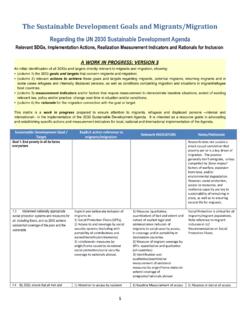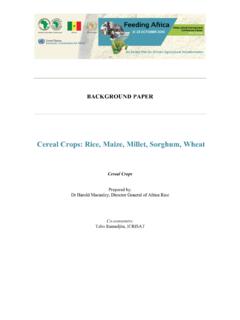Transcription of Climate Change, Natural Disaster and Rural Poverty in Ethiopia
1 1 | P a g e Climate change , Natural Disaster and Rural Poverty in Ethiopia - Gutu Tesso (PhD) 1. Ethiopia Country Overview Ethiopia is home to close to 100 million people, and it currently stands to be the second most populous country in Africa. Agricultural sector contributes about 43% of the Gross Domestic Product (GDP), 80% of employment, and 90% of export (Demese et al., 2010). Smallholder farmers account for more than 85% of the Rural population that relies on agricultural production.
2 Ethiopia has liberalized its economy and developed Poverty reduction strategies that underpin market-led strategies for broad based agricultural development, Poverty reduction and economic growth. Within the broader strategy, the focus given to support smallholder farming is believed to be the key Rural households Poverty reduction. Given the total sum of the population that directly and indirectly make their livelihoods from the sector; its development is viewed as a means to improve the living standards of smallholders and generate economic growth.
3 However, the production is still characterized by low output, poor access to land, poor access to inputs, poor irrigation system, little access to know-how (risk management, technology, and skill), low level of market orientation, poor infrastructure and under developed institutions (Aman et al, 2014 quoted from Bezabih and Hadera, 2007; CSA, 2009; MoFED, 2005; Tilaye, 2010). The aforementioned challenges and the numerous development constraints exacerbate the nation s vulnerability to Climate change , resulting in high levels of food insecurity and ongoing conflicts over Natural resources.
4 Chronic food insecurity affects 10 percent of the population, even in years with sufficient rains. Roughly two-thirds of the population earns less than $2 per day and access to basic services is limited. The Rural livelihood systems crop cultivation, pastoralism and agro-pastoralism are highly sensitive to Climate . Food insecurity patterns and the Poverty of Rural households are linked to seasonal rainfall patterns, with hunger trends declining significantly after the rainy seasons.
5 Climate variability already negatively impacts livelihoods and this is likely to continue. Drought is the single most destructive Climate -related Natural hazard in Ethiopia . Estimates suggest Climate change may reduce Ethiopia s GDP up to 10 percent by 2045, primarily through impacts on agricultural productivity. These changes also hamper economic activity and aggravate existing social and economic problems (London School of economics, 2015; US Embassy, 2016; USAID, 2015). 2. Climate change and Natural Disaster Ethiopia is vulnerable to Climate change induced disasters such as drought, epidemics, flood, conflict, earthquake, pests, wildfire and landslide, amongst others.
6 These different hazards occur with varying frequency and severity. Some result in nationwide disasters, while the impacts of others are more localized (Adane et al., 2006). There have been many national and localized droughts in the past and communities managed most of them through their own coping mechanisms. Between the Great Famine and the 1970s at least 20 major drought years were noted affecting most parts of the country, particularly in Tigray and Wollo.
7 The magnitude, frequency and the effects of droughts have increased since the mid-1970s (USAID, 2003). The frequency of nationwide droughts causing severe food shortage increased from once every 10 years in the 1970s and 1980s, to every three years now. Between 1970 and 1996, drought and the resultant food shortages have affected millions. The effects of drought are often combined with other hazards. Migratory pest infestation (locusts) has been a serious problem in some parts of the country and the prevalence of some crop diseases increase when climatic conditions are favorable (USAID, 2003).
8 2 | P a g e The increasing trend of drought-induced Disaster , associated with other hazards, is reflected in the increasing number of people needing food assistance in Ethiopia . Between 1990 and 2005, on average, each year million people required food assistance amounting to over 654,000 tons annually. These number has now increased to closer to 10 million during the past 10 years. These are people who need food assistance during normal years by being included into the government s productive safety net program.
9 During the drought years, apart from those in the safety net program, the number of people affected is especially significant in Tigray where an annual average of more than million people is affected in districts labeled as hotspot. The proportion of the population affected is also high in Amhara and Somali regional states. The number of people affected by drought in 2003 alone was more than 13 million (DPPA, 2005). Epidemics, both human and livestock, are also another Climate change induced shocks which lead greater famine like that of the Great Famine of Ethiopia (Adane et al.)
10 , 2006). Another Climate variability induced shock in Ethiopia is also flood. Flooding caused by rivers overflowing their banks has regularly affected people and their properties, especially in the lowland areas of Somali, Afar, Gambella, Oromia and Amhara regional states. Flash floods affect all regions. Some floods, such as those in 1996 and 2006, triggered disasters which claimed the lives of hundreds of people, displaced hundreds of thousands and destroyed physical, Natural and economic assets.














